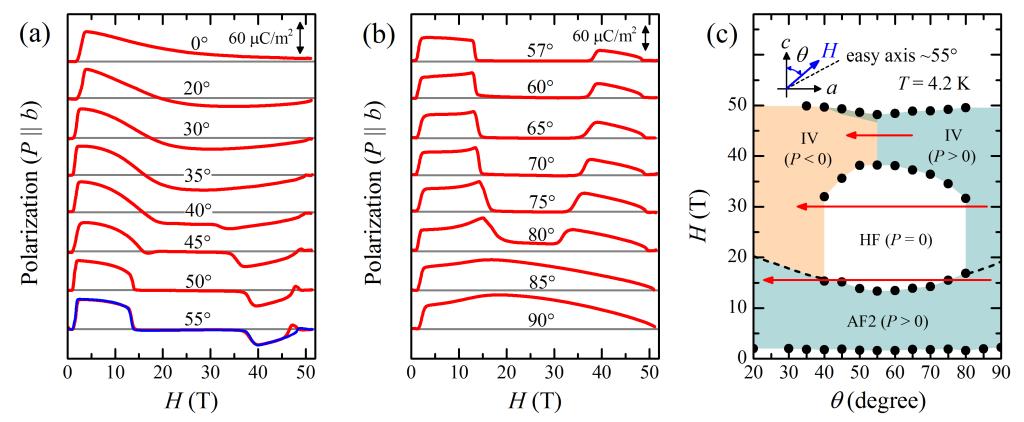
(a), (b) Magnetic field dependence of electric polarization in MnWO4 measured at 4.2 K by rotating field in the ac plane. (c) The H-θ phase diagram at 4.2 K.
Background
One of the most intriguing phenomena in multiferroic materials is the magnetic-field (H) induced electric polarization (P) switching, reorientation of P by 90° (flop) or 180° (reversal), that has been observed since the discovery of magnetoelectric coupling in the rare-earth manganites. Recently, the observation of the P switching in Co2V2O7 was assumed to correlate with magnon Bose-Einstein condensation; the concept of multiferroic quantum criticality was proposed and accounted for the high-field P reversal in BiMn2O5. To date, understanding the microscopic interplay between magnetism and electricity in these materials is essential and still an open issue.
What we discover?
In this work, we performed comprehensive ferroelectric polarization measurements on MnWO4 in fields up to 52 T and with rotating field direction in the ac plane. When the field is rotated from H||c to H||u (u is the magnetic easy axis), we find that the induced high-field phase (−P||b) favors a sign reversal relative to the low-field +P||b phase. Particularly, further slight deviation of the field from the magnetic easy axis towards H||a causes an abrupt reversal of the high-field phase from −P||b to +P||b. This unusual angular dependent polarization reversal has been discovered both at 4.2 K and 8.8 K. In addition, we reveal that the polarization polarity close to the high-field ferroelectric phase transition (second order) can be switched by an electric field.
Why is this important?
A long-standing issue in multiferroic MnWO4 is the electric polarization reversal when magnetic field is applied along the magnetic easy axis (H||u). Our results elucidate how this reversal appears when H is rotated from c to u without considering the P flop and the memory effect. This is attributed to the vector spin chirality changing from one side of the spin connecting vector to the other. Remarkably, we uncover a new polarization reversal that, when H is further canted towards the a axis, the high-field ferroelectric phase suddenly changes its polarity, which results from a change of the helicity of the spiral spin structure under a strong magnetic field. This study results in an overall understanding of this important multiferroic material and sheds light on field-induced polarization switching in related compounds.
Why did we need WHMFC?
High-field electric polarization up to 52 T was measured by the pyroelectric technique using a 10.5-ms pulsed magnet at the Wuhan National High Magnetic Field Center (WHMFC), China. A high precision quartz rotator was used in our experiments for the angular dependent measurements of P (H). This experimental technique has already been successfully developed in the WHMFC.
Who did the research?
J. F. Wang,1 W. X. Liu,1 Z. Z. He,2,* C. B. Liu,3 M. Tokunaga,4 M. Li,5 C. Dong,1 X. T. Han,1 F. Herlach,1 C. L. Lu,1 Z. W. Ouyang,1 Z. C. Xia,1 K. Kindo,4 L. Li,1 and M. Yang1,†
1Wuhan National High Magnetic Field Center and School of Physics, Huazhong University of Science and Technology, Wuhan 430074, China.
2State Key Laboratory of Structural Chemistry, Fujian Institute of Research on the Structure of Matter, Chinese Academy of Sciences, Fuzhou, Fujian 350002, China.
3School of Physics and Electronic Engineering, Nanyang Normal University, Nanyang 473061, China.
4The Institute for Solid State Physics (ISSP), University of Tokyo, Chiba 277-8581, Japan.
5Department of Physics and Physical Oceanography, Memorial University, St. John’s, Newfoundland, Canada.
Acknowledgments
J.F.W. would like to thank Z. Wang in the High Magnetic Field Laboratory of China (Hefei) for helpful discussions. This work was supported by the National Natural Science Foundation of China (Grants No. 12074135, No. U1832214, No. 21875249, No. 12004122, No. 51821005, and No. 11774106) and the Fundamental Research Funds for the Central Universities (Grants No. 2018KFYXKJC005 and No. 2019KFYXJJS009).
Link
https://doi.org/10.1103/PhysRevB.104.014415
